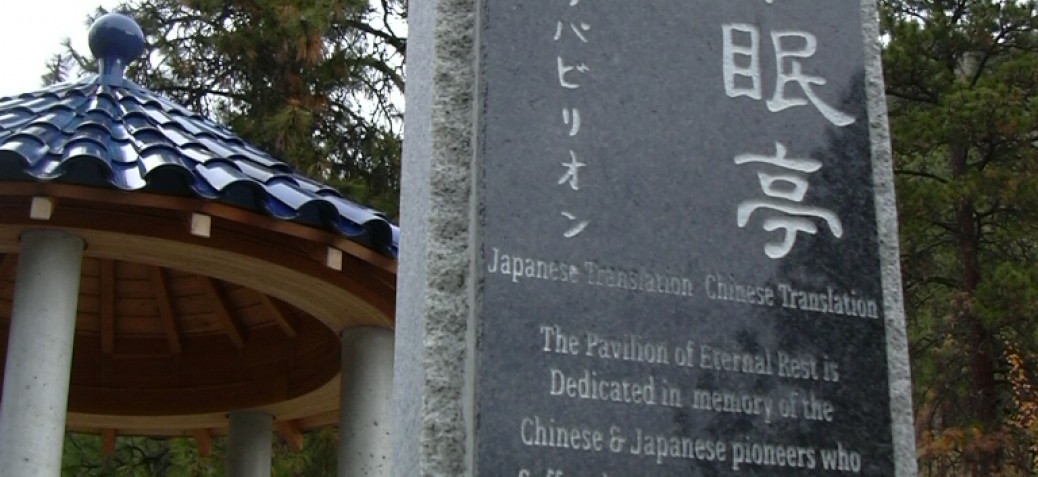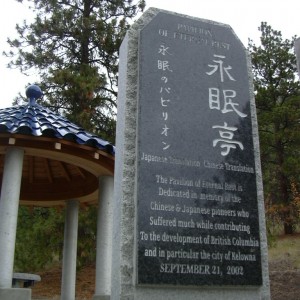Kelowna Memorial Park Cemetery
Place Description
Kelowna Memorial Park Cemetery occupies a picturesque site east of Spall Road, at the base of Dilworth Mountain, with rolling topography and panoramic views to the south. The City of Kelowna has operated the Cemetery since 1911. Prior to this it had been established as a small public burying ground. Over time, an adjacent Anglican cemetery and the private Hardy Family cemetery were established, now amalgamated and expanded until the cemetery reached its current size of 20 hectares. In total, the Kelowna Memorial Park Cemetery contains over 15,000 interments. Sections A and B are the "dry" parts of the Cemetery, and are defined as family maintenance areas. Section A contains the earliest pioneer parts of the Cemetery. Other sections consist of grassed terrain, with raised markers and lawn markers, with many mature trees and plantings.
Heritage Value
The Kelowna Cemetery is valued as the oldest operating cemetery in Kelowna, which over time has adapted to shifts in the population and community. A physical testament to the strength and continuity of the people of Kelowna, the cemetery embodies a collective memory and spirit. A wide variety of people are interred at the cemetery including different ethnic, secular and religious groups and many community members who reflect the history, development, heroics and tragedies of Kelowna, with local, provincial and national associations. There is a direct connection to pioneer families, including the Anglican parish and other denominations, and noted local figures including former Premier W.A.C. Bennett (1900-1979). Reflecting the diversity of the community, an Asian section is located in the original part of the cemetery.
The first European burial ground in the area was established for Catholics at the Pandosy Mission. Non-Catholics were buried on their rural properties, or sent elsewhere for burial, until this public cemetery was established in the Glenmore District in 1892, on the lower slopes of Dilworth Mountain. An Anglican burying ground was established in 1894 on the adjacent property. In 1911, the city officially took over operation of the public cemetery. In 1930, the Anglican cemetery was absorbed by the public cemetery. The second "dry" section was established in the 1940s, the first lawn section was established in the 1960s, and other property has also been added, resulting in the Cemetery's current configuration. The unique, 'dry' nature of the cemetery, with curbed plots in the original sections set in gravel beds rather than grassed, is reflective of the arid local climate. The cemetery also adjoins areas of natural habitat on the mountain slopes.
The cemetery features many decorative and unique monuments and headstones, ranging in materials from wood to stone and metal, which illustrate the changing nature of memorialization through time. The headstones and markers display a variety of materials such as roughcast and polished granite, sandstone, and cement, in styles such as upright and ledger stones, including many personal and hand-made personal memorials. The “dry” areas have extensive curbing. The style and size of the markers help to delineate the different sections of the cemetery.
The cemetery continues to be an important part of community life, with connections to many local families. Members of the community have identified pioneers and participated in fundraising to put headstones in place, hereby commemorating their ancestors. In 2000-01, the heritage sections of the cemetery were extensively restored with community assistance, including: new curbs; restoration of the Asian Section; repair and replacement of deteriorated headstones; and the construction of a commemorative pavilion, reflecting the value placed on Kelowna Memorial Park Cemetery by the local community.
Character Defining Elements
Key elements that define the heritage character of the Kelowna Memorial Park Cemetery include its:
- continuous use as a burial ground since 1892
- location on the south slopes of Dilworth Mountain, on rolling topography with expansive views to the south and many mature trees and plantings
- earliest areas in the including the pioneer Section A, including the original “dry” burying ground; the Anglican Cemetery, the Asian Section, and the Hardy Family Cemetery
- variety of headstone styles such as shouldered and screen headstones, and flat plaque markers
- variety of headstone materials such as carved granite, cement, limestone, sandstone, and metal
- variety of gravestone symbols such as epitaphs, religious or animal symbolism, body symbolism, and fraternal and social organizations
- gravestones footed with cement convex ground ledgers or cement or granite curbing delineating family plots
- different methods of commemoration over time, including the move to horizontal lawn markers, with orderly and open spatial qualities on evenly graded topography that were used after the 1960s, and family maintenance areas





